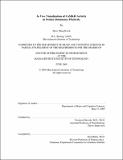In vivo visualization of CaMKII activity in ocular dominance plasticity
Author(s)
Kwok, Show Ming
DownloadFull printable version (2.649Mb)
Other Contributors
Massachusetts Institute of Technology. Dept. of Brain and Cognitive Sciences.
Advisor
Yasunori Hayashi.
Terms of use
Metadata
Show full item recordAbstract
Alterations in sensory experience can persistently modify the responses of cortical neurons. Ocular dominance (OD) plasticity, a process in which alternation of visual input induces a shift in cortical responsiveness, is an extensively studied model of such experience-dependent plasticity. However, the synaptic mechanisms underlying OD plasticity are not well understood. Recent studies revealed that both Hebbian and homeostatic mechanisms play a role in OD plasticity. Therefore, we were interested in monitoring the process of rapid plasticity at individual synapses in vivo to gain insight into the interplay of these two mechanisms. Ca2+/calmodulin dependent protein kinase II (CaMKII) is a major component of the postsynaptic density. Activation of CaMKII is necessary and sufficient for LTP induction, is required for OD plasticity, and its expression pattern coincides with the site of rapid plasticity in the supragranular layers II/III of the visual cortex. Moreover, CaMKII can convert transient Ca2+ influx into a prolonged biochemical process via autophosphorylation that renders CaMKII activity Ca2+ independent. Hence, CaMKII is well suited as a reporter of synaptic activity. We previously engineered a probe, Camui, which utilizes the optical phenomenon of fluorescence resonance energy transfer (FRET), to monitor CaMKII activation. This thesis embodies the work done to improve Camui to be a better tool for in vivo reporting of CaMKII activity, as well as the use of this improved probe for in vivo detection of CaMKII activity in single spines before and after 4 hrs of monocular deprivation (MD) in the ferret visual cortex. (cont.) We found that after only 4 hrs of MD, the overall CaMKII activity in spines, and adjacent dendritic regions, of neurons in the deprived eye domain increased significantly. This increase was also seen in the binocular eye domain. In the open eye domain, however, this overall increase in CaMKII activity was absent. These observations were specific to MD as control experiments did not show such changes. Moreover, detailed analysis revealed that spines that were eliminated after 4 hrs of MD had a low level of basal CaMKII activity. Our results lend support to the model that both Hebbian, as well as homeostatic compensatory mechanism can subserve OD plasticity.
Description
Thesis (Ph. D.)--Massachusetts Institute of Technology, Dept. of Brain and Cognitive Sciences, 2009. This electronic version was submitted by the student author. The certified thesis is available in the Institute Archives and Special Collections. Includes bibliographical references.
Date issued
2009Department
Massachusetts Institute of Technology. Department of Brain and Cognitive SciencesPublisher
Massachusetts Institute of Technology
Keywords
Brain and Cognitive Sciences.